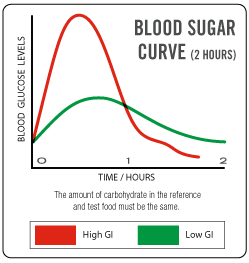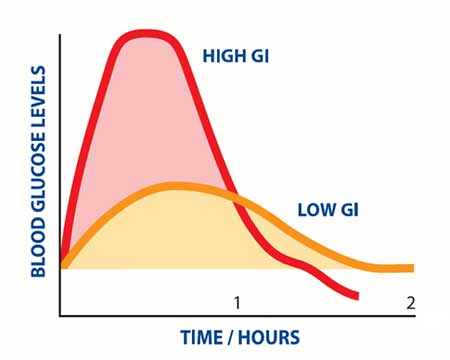Why The Glycemic Index Is Misleading:
by AsgardFit
You have heard of it, I have heard of it, even your mom has heard of it. Men’s Health talks about it every month. Shape, Self, Women’s Health, Men’s Fitness, and virtually every health and fitness magazine discusses it and preaches its universal wisdom. In most of our minds, the glycemic index (GI) is the holy grail of determining how good/bad certain carbs are for us. What if I told you that the GI may not be that amazing of a tool to use, and in fact it might be causing more problems than it solves? Well be prepared for just that.
What is the Glycemic Index?
I know we all hate Wikipedia, but in my mind their definition and explanation was quite accurate and thorough.
“The glycemic index, or glycaemic index, (GI) provides a measure of how quickly blood sugar levels (i.e. levels ofglucose in the blood) rise after eating a particular type of food. The effects that different foods have on blood sugar levels vary considerably. The glycemic index estimates how much each gram of available carbohydrate (total carbohydrate minus fiber) in a food raises a person’s blood glucose level following consumption of the food, relative to consumption of pure glucose.[1] Glucose has a glycemic index of 100.
A practical limitation of the glycemic index is that it does not take into account the amount of carbohydrate actually consumed”.
 Why is this important? Well the degree to which your blood sugar raises due to the food you ingest has a direct effect on the amount of insulin your pancreas produces to direct that insulin to the various tissues in your body for storage or utilization for energy. In the most simple terms, the higher the blood glucose levels the higher the insulin response required to take care of the high blood sugar. In general, large insulin spikes are considered to be negative in that they require your pancreas to produce a large amount of insulin and your body cycles from high blood sugar to low blood sugar, and with that goes your energy levels (If your body is tuned to carbohydrate utilization and not fat utilization).
Why is this important? Well the degree to which your blood sugar raises due to the food you ingest has a direct effect on the amount of insulin your pancreas produces to direct that insulin to the various tissues in your body for storage or utilization for energy. In the most simple terms, the higher the blood glucose levels the higher the insulin response required to take care of the high blood sugar. In general, large insulin spikes are considered to be negative in that they require your pancreas to produce a large amount of insulin and your body cycles from high blood sugar to low blood sugar, and with that goes your energy levels (If your body is tuned to carbohydrate utilization and not fat utilization).
This all sounds great in theory right? If a food has a high GI, then it requires more insulin to stabilize the blood sugar and overtime high GI foods can lead to insulin resistance because of the continual release of high levels of insulin. Well, that is true, but I believe it is more complicated than that. In fact, in my mind, I believe it is the length of time your cells are exposed to insulin and not necessarily the short high spikes that cause systemic insulin resistance. An explanation I will return to in a minute.
I believe this makes an excellent segue-way into my next topic, the glycemic load.
The Glycemic Load
Once again, I must defer to the devil itself (Wikipedia) for a definition here. “The glycemic load (GL) of food is a number that estimates how much the food will raise a person’s blood glucose level after eating it. One unit of glycemic load approximates the effect of consuming one gram of glucose.[1] Glycemic load accounts for how much carbohydrate is in the food and how much each gram of carbohydrate in the food raises blood glucose levels. Glycemic load is based on the glycemic index (GI). Glycemic load is defined as the grams of available carbohydrate in the food x the food’s GI / 100.
Glycemic load estimates the impact of carbohydrate consumption using the glycemic index while taking into account the amount of carbohydrate that is consumed. GL is a GI-weighted measure of carbohydrate content. For instance,watermelon has a high GI, but a typical serving of watermelon does not contain much carbohydrate, so the glycemic effectof eating it (and therefore its GL) is low. Whereas glycemic index is defined for each type of food, glycemic load can be calculated for any size serving of a food, an entire meal, or an entire day’s meals”.
 To understand the Glycemic Load (GL) in a graph, it is essentially the area under the curve (the shaded portion). It represents the total effect that the food has on blood glucose levels over a period of time. This is an important distinction from the GI.
To understand the Glycemic Load (GL) in a graph, it is essentially the area under the curve (the shaded portion). It represents the total effect that the food has on blood glucose levels over a period of time. This is an important distinction from the GI.
THE DIFFERENCE BETWEEN GI AND GL
The main difference between the GI and the GL is that the GI represents the maximal response of the blood glucose in the body to a given food. It does not represent the “load” on the system, the length of time the blood glucose levels are elevated or the total amount of insulin the body will have to produce to deal with the amount of carbohydrate. On the other hand, the GL does take into consideration all of those factors and more accurately represents the load the food is placing on the body’s blood glucose management system (the battle between insulin and glucose).
MAXIMAL SUGAR VS OVERALL LOAD
To accurately convey my point on the GI I want to put forth an example. The first is the issue of the maximal blood sugar load the GI measures. On this point, I believe this is important in regards to the idea that yes, high levels of blood sugar are generally unhealthy and foods that promote high levels of blood sugar are not optimal in most circumstances. For instance, consuming Banana for breakfast has a GI of 62, where consuming a sweet potato has a GI of 54. Now in this example we would say the Banana is worse for our blood sugar because it has a higher GI, indicating our body produces higher Maximal insulin at a quicker rate due to more simple sugars and more easily broken down sources of glucose in the food. Now if we look at the GL of these foods we find that the GL of a banana is actually lower than the sweet potato at 16 and 20 respectively. So while the banana prompted a higher initial level of blood sugar and the appropriate insulin response, the overall effect on blood glucose was lower and required less overall insulin production by the pancreas.
WHAT DOES THIS MEAN FOR OUR CELLS?
While the example above does not hold in all cases, I believe it is a good one to highlight my point. In this case, the banana provides a relatively quick bolus of glucose to the body, your pancrease produces a burst of insulin to deal with that glucose ( a pulsatile response like most other hormones). The glucose gets sequestered into the cells quickly and then there is no more issues with where to put the nutrients and the pancreas gets a rest (Think power lifting here folks, work hard, work fast, work smart, then rest and recover!). In this case our cells are exposed to insulin for a short period of time, the cells do their transcription and translocation magic of receptors and deal with the nutrients. Then they are done and get a break from the insulin.
With the sweet potato, the blood sugar rise is slower and longer and creates a greater total glucose load. In response, the pancreas secretes insulin for a longer period of time (no longer a quick pulse), the cells are exposed to more insulin over a longer period of time, and are subject to the demands of that insulin. This is the big issue in my mind. An increase in the total exposure to insulin is more likely to result in insulin resistance due to prolonged exposure and nutrient partitioning than a short quick exposure.
Now here is where it gets a little dicey. I am not indicating that we should be eating high GI foods, not at all. In fact, I would be irresponsible to suggest that. What I am suggesting is that we need to be careful of what we choose to use as a tool to examine the effect of carbohydrates on the body. Concomitantly, most foods with a high GI also have greater GL than those with a low GI, but it is not always the case as we have seen here.
SHOULD WE TOSS OUT THE GI?
Now is this to say that the GI is pointless? No, I do not believe it is pointless as many of the low GI foods are indeed lower on the GL and healthier in general, but the GI is not a “catch-all”. In fact, recent studies have shown that the GI does have a correlation with obesity, type II DM, metabolic syndrome, and a host of other lifestyle based diseases (1-2). Although these studies also showed that the lower GI diets were indeed lower on the GL scale as well. However, it does not accurately indicate the full impact foods have on your body. More information is necessary and ought to be considered when determining your carbohydrate sources than the GI. There are a myriad of things that affect why our cells develop insulin resistance, gain weight, develop type II DM, etc. Ultimately, like any other tool, the GI is just that, a tool. It is designed for a specific job, to measure the maximal blood glucose level a certain food will elicit, and we would be prudent to remember that.
1. Jenkins DJ, Kendall CW, Augustin LS, et al. Glycemic index: overview of implications in health and disease. The American Journal of Clinical Nutrition. 2002;76(1):266S–273S.
